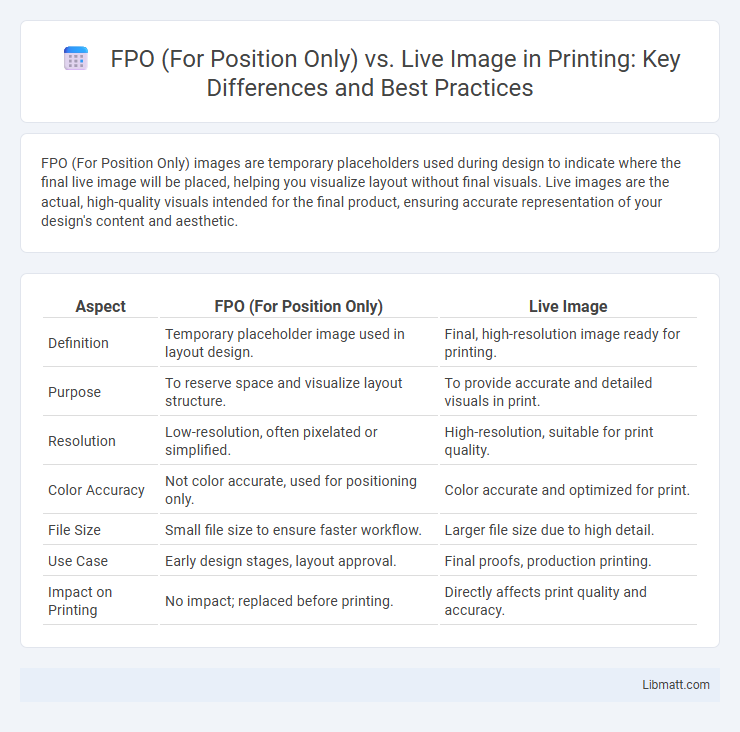FPO (For Position Only) images are temporary placeholders used during design to indicate where the final live image will be placed, helping you visualize layout without final visuals. Live images are the actual, high-quality visuals intended for the final product, ensuring accurate representation of your design's content and aesthetic.
Table of Comparison
| Aspect | FPO (For Position Only) | Live Image |
|---|---|---|
| Definition | Temporary placeholder image used in layout design. | Final, high-resolution image ready for printing. |
| Purpose | To reserve space and visualize layout structure. | To provide accurate and detailed visuals in print. |
| Resolution | Low-resolution, often pixelated or simplified. | High-resolution, suitable for print quality. |
| Color Accuracy | Not color accurate, used for positioning only. | Color accurate and optimized for print. |
| File Size | Small file size to ensure faster workflow. | Larger file size due to high detail. |
| Use Case | Early design stages, layout approval. | Final proofs, production printing. |
| Impact on Printing | No impact; replaced before printing. | Directly affects print quality and accuracy. |
Introduction to FPO (For Position Only) and Live Image
FPO (For Position Only) images are low-resolution placeholders used in design layouts to represent where the final artwork or photos will appear, ensuring proper spacing and composition without distracting from the design process. Live images, on the other hand, are high-resolution, final visuals intended for actual use in print or digital media, showcasing true colors, details, and quality. Understanding the distinction helps your design team efficiently manage workflow stages from draft to final production.
What is an FPO Image?
An FPO (For Position Only) image is a temporary placeholder used in design projects to represent where the final live image will be placed. It helps designers plan layout and composition without the need for high-resolution files, streamlining the creative process. Your workflow benefits by visually aligning elements early, ensuring accurate placement before the final images are imported.
Defining Live Images in Design
Live images in design refer to final, high-resolution visuals fully integrated into a project, accurately representing color, detail, and composition intended for production or publication. Unlike FPO (For Position Only) images, which serve as temporary placeholders to establish layout structure, live images ensure precise design evaluation and client approval. Using live images eliminates discrepancies during printing or digital display, maintaining brand consistency and quality standards.
Key Differences Between FPO and Live Images
FPO (For Position Only) images are low-resolution placeholders used in design layouts to indicate where the final image will be placed, while live images are fully processed, high-resolution visuals intended for final output. FPO images lack detailed color accuracy and image quality, serving primarily for spatial arrangement and workflow efficiency. Your design process benefits from distinguishing these two by ensuring FPOs are replaced with live images before printing or publishing to maintain professional quality.
When to Use FPO Images in Projects
FPO (For Position Only) images are essential during early design stages to quickly establish layout and spatial relationships without requiring final visuals, allowing for efficient project iterations. Use FPO images when the focus lies on structure, composition, or client approval before committing to high-resolution or live images. Your project workflow benefits from FPO placeholders by saving time and resources until live images are finalized for the final production phase.
Advantages of Using Live Images
Live images offer accurate color representation, sharp details, and true-to-life textures that enhance visual appeal and professionalism in your design projects. Using live images eliminates guesswork associated with FPO placeholders, ensuring that layout and composition reflect the final output precisely. This leads to better client presentations, smoother approval processes, and a more reliable preview of the finished product.
Potential Risks of Misusing FPO Images
Misusing FPO (For Position Only) images can result in significant design errors, including inaccurate color representation, resolution mismatch, and incorrect scaling, which may lead to compromised print quality or digital display issues. Relying on FPO images during final production increases the risk of brand inconsistency, as these placeholders often lack proper trademarks, watermarks, or final content details, potentially causing legal and marketing complications. Failure to replace FPO with live images before publishing can damage professional credibility, resulting in miscommunication and negative user experience across websites, advertisements, or printed materials.
Best Practices for Replacing FPO with Live Images
Replacing FPO (For Position Only) images with live images requires maintaining consistent resolution and color profiles to ensure visual accuracy across final designs. Using high-quality live images that match the dimensions and aspect ratios of FPO placeholders prevents layout shifts and preserves design integrity. Implementing version control and thorough quality checks before publishing guarantees that all FPO elements are correctly substituted with finalized visuals.
FPO vs Live Images in Print vs Digital Media
FPO (For Position Only) images serve as placeholders in print and digital media layouts, enabling designers to focus on composition without final image details. Live images provide the high-resolution, color-accurate visuals essential for print quality and vibrant digital displays, ensuring your content appears polished and professional. In print media, live images must meet strict DPI and color profiles, while digital platforms prioritize web-optimized formats and load speeds for optimal user experience.
Summary: Choosing Between FPO and Live Images
FPO (For Position Only) images serve as placeholders in design layouts to indicate where the final visuals will be placed, allowing for faster initial development without affecting file size or load times. Live images, however, are high-quality, finalized graphics used in the final production stage to ensure accurate color, resolution, and visual impact. Selecting between FPO and live images depends on the project phase, with FPOs optimizing workflow efficiency early on and live images enhancing visual fidelity in completed designs.
FPO (For Position Only) vs Live Image Infographic

 libmatt.com
libmatt.com